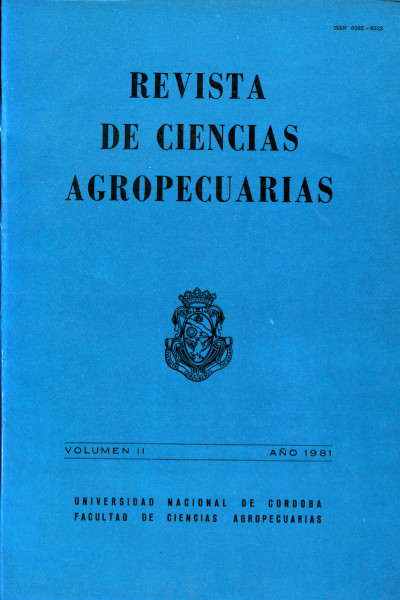Response of N, P and fertilization on non nodulated soybean CV. Halesoy 71
Main Article Content
Abstract
Article Details
How to Cite
References
BHANGOO, M. S. y ALBRITTON, K. J. 1972. Effect of fertilizer nitrogen phosphorus and potassium of yield and nutrient content of lee soybean Agron. J. 64(6): 743-747.
CALDWELL, B. E. 1973. Soybean, impwovement, production and uses. Madison. Wisconsin E.U.A. Am. Soc. of Agionoiny.
de MOOY, C. J.; PESEK, J. y SPALDON, E. 1973. Mineral nutrition. In Caldwell, B. E. ed. Soybean, improvements, production and uses. Madison, Wisconsin. E.U.A. American Society of Agronomy. pp. 285-287.
FLETCHER, H. F. Diferencial effect of phosphorus fertiity on soybean varieties. Ph. D. dissertation, University of Illinois, Urbana, I 11 (mic. 62-596. Univ. Microfilms, Ann Arbor, Mich. Diss. Abstr. 22:3326-3327) (original no consultado: citado en Caldwell B.E. ed. Soybean: improvement, production, and uses. Madison, Wisconsin. E.U.A. American Society of Agronomy. 1973. p. 289).
HANMOND, L. C.; BLACK, C. A.; NORMAN, A. G. 1951a. Nutrient uptake by soybean on two Iowa sci's Iowa Agr. Exp. Sta. Res. Bull. 3384 (Original no consultado; citado en Caldwell, B E. ed. Soybean: improvement production and uses. Madison, Wisconsin, E.U.A. American Society of Agronomy 1973. pp. 267-268.
HANNWAY, J. J. y WEBER, C. R. 1971b. Dray matter accumulation in soybean (Glycine max L.) pants as influenced by N, P and K fertilization. Agron. J. 63(2): 263-266.
HANWAY, J. J. y WEBER, C. R. 1971. N, P and K percentages in soybean (Glycine max. L.) jeant parts. Agron. J. 63(3): 406-408.
HARPER, J. E. y COOPER, R. L. 1971. Nodulation response of soybean (Glycine max Merr) to application sates and p'acement combined nitrogen. Crop. Sci. 11(3): 438-440.
HARPER, J. E. 1974. Soil and simbiotic nitrogen requirements for optimun soybean production. Crop. Sci. 14(2): 255-260.
LAWN, K S. y BRUN, W. A. 1974. Simbiotic nitrogen fixation in soybeans. Effect of suplemental nitrogen and inteivarietal grafting. Crop. Sci. 14(l): 22-26.
LATHWELL, J. C. y EVANS, C. E. 1951. N uptake from solution by soybeans at successive stage of growth. Agron. J. 43: 264-270.
LYONS, J. C. y EARLY, E. B. 1973. The effect of ammonium nitrate aplicaGus to field soilds, on modulation, seed yield, and nitrogen and oil content of the seed of soybeans. Proc. Soil Sci. Soc. Amer. 16:259-263 (original no consultado, citado en Ca dwell, B. E. ed. Soybean: Improvement, production and uses. Madison, Wisconsin, E.U.A. American Society of Agronomy. p. 279).
MILLER, R. J. et al. 1961. Relationships betwen soybean yield and concentrations of phosphorus and potassium in plant parts. Agron. J. 53: 393.396.
MOOY, C. J. y PESEK, J. 1969. Growth and yield soybean lives in relation to phosphorus toxicity and phosphorus, potassium and calcium. Crop. Sci. 9: 130-134.
NEUNILOV, B. A. y SLABKO, U. I. 1968. Utilization of nitrogen from fertilizers applied at varius time. Agrochimiya 12: 3-9 (R). (original no consultado, citado en Caldwell, B. E. ed Soybeans: improvement, production and uses. Madison, Wisconsin, E.U.A. American Society of Agronomy. 1973. pp. 274-283.
NORMAN, A. G. 1944. The nitrogen nutrition of soybean. Effect of inoculation and nitrogen fertilizer cn the yiel dand composition of beans on Marshall silt loam. Soil Sci. Amer. Proc. 8: 226-228.
NORMAN, A. G. y KRAMPITZ, L. O. 1946. The nitrogen nutrition of soybeans. Effect of available soil nitrogen, en growth and nitrogen fixation. Soil Sci. Soc. Amer. Proc. 10: 191-196.
OHLROGGE, A. J. 1960. Mineral nutrition of soybeans. Advances Agron. 12: 229-262.
RACCA, E W. y BODRERO, M. L. 1976. Influencia de la fertilización con N en soja nodulada cv. Halesoy 71 (en prensa).
SCOTT, W. O. y ALDRICH, S. R. 1975. Producción moderna de la soja. Buenos Aires, Hemisferio Sur. pp. 67-99.
TANNER, J. W. y ANDERSON, I. C. 1963. External effect of combined nitrogen on nodulation. Plant Phys. 39. 1039:1043.
WEBER, C. R. 1966. Nodulation and nonnodulating soybean isolines. Lespouse to app'ied nitrogen and modifier soil conditions Agron. J. 58(l): 46-49.





